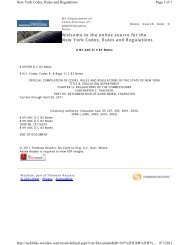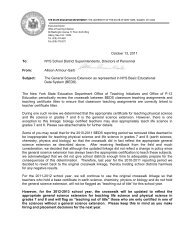ESL Learning Standards - Higher Ed - New York State Education ...
ESL Learning Standards - Higher Ed - New York State Education ...
ESL Learning Standards - Higher Ed - New York State Education ...
You also want an ePaper? Increase the reach of your titles
YUMPU automatically turns print PDFs into web optimized ePapers that Google loves.
tions on a wide range of familiar and unfamiliar topics in a number of modalities.<br />
Transitional students apply their linguistic skills and knowledge, including vocabulary,<br />
idioms, and complex grammatical structures, to content area learning. These<br />
students are able to use paralinguistic features of the language, such as stress, intonation,<br />
pace, and rhythm, to understand spoken language. Transitional level students<br />
still benefit from aural support in the academic content areas through techniques<br />
such as use of visuals, paraphrasing, and comprehension checks.<br />
Speaking: Students at the transitional stage can engage in most social communicative<br />
situations with confidence and mastery of complex language structures.<br />
Speaking in the academic content areas is characterized by fluency and accuracy<br />
in language production, with some circumlocution regarding technical content area<br />
vocabulary and some language forms.<br />
Reading: Students at the transitional stage understand and obtain meaning from a<br />
wide range of texts available to native English speakers. They have mastered the<br />
strategies of reading comparable to native English-speaking students at their grade<br />
level and are approaching grade-level mastery of the language structures and<br />
vocabulary that are characteristic of texts in the academic content areas.<br />
Writing: Students at this stage are approaching fluency in writing in the content<br />
areas, using the language structures and technical vocabulary of each area with<br />
some circumlocutions. They begin to use alternative and nuanced meanings of<br />
words in their written communications. They demonstrate an increasing ability to<br />
successfully employ the subtleties of written language for different audiences and<br />
purposes.<br />
The <strong>New</strong> <strong>York</strong> <strong>State</strong> <strong>ESL</strong><br />
<strong>Learning</strong> <strong>Standards</strong>:<br />
• Align the NYS ELA standards<br />
with the TESOL<br />
standards<br />
• Develop language and<br />
academic skills for content<br />
area learning<br />
• Recognize and build on<br />
the cultural diversity of<br />
the population<br />
• Provide a framework for<br />
<strong>ESL</strong> learning experiences,<br />
classroom practices, and<br />
curriculum development<br />
• Set the parameters for<br />
<strong>ESL</strong> assessment<br />
DEVELOPMENT OF THE NYS <strong>ESL</strong> LEARNING STANDARDS<br />
The NYS <strong>ESL</strong> learning standards are based on an alignment between the <strong>New</strong> <strong>York</strong><br />
<strong>State</strong> English language arts (ELA) learning standards and the <strong>ESL</strong> standards developed<br />
by the national association of Teachers of English to Speakers of Other<br />
Languages (TESOL). The NYS <strong>ESL</strong> standards reflect the standards-based curriculum<br />
and assessment initiatives promulgated by <strong>New</strong> <strong>York</strong> <strong>State</strong> <strong>Ed</strong>ucation Department.<br />
In addition, they incorporate ideas, information, and concepts gleaned from <strong>ESL</strong><br />
standards from other states, cities, and organizations, the languages other than<br />
English (LOTE) standards in <strong>New</strong> <strong>York</strong> <strong>State</strong>, and The Teaching of Language Arts to<br />
Limited English Proficient/English Language Learners: A Resource Guide for All<br />
Teachers, published by the NYSED Office of Bilingual <strong>Ed</strong>ucation. Cross-referencing<br />
these sources produced a document that provides consistency in goal and mission<br />
in <strong>New</strong> <strong>York</strong>, and one that is unique to the specific discipline of <strong>ESL</strong>.<br />
In the spring of 2000, NYSED identified a task force of educators of <strong>New</strong> <strong>York</strong><br />
<strong>State</strong>’s LEP/ELLs to advise on the development of a statewide <strong>ESL</strong> achievement test.<br />
The task force participated in the development of a conceptual framework for the<br />
achievement test, a set of language and learning objectives that represent high levels<br />
of achievement for all LEP/ELLs throughout the <strong>State</strong>. From these initial discussions<br />
the <strong>New</strong> <strong>York</strong> <strong>State</strong> <strong>ESL</strong> learning standards were created.<br />
With the assistance of the Center for Applied Linguistics, the <strong>ESL</strong> <strong>Standards</strong><br />
Committee aligned the TESOL standards with the ELA standards for each grade<br />
level cluster, and developed new performance indicators as needed.<br />
Simultaneously, teams of teachers around the <strong>State</strong> identified and developed sample<br />
classroom tasks that addressed the standards and performance indicators and<br />
that illustrated standards-based <strong>ESL</strong> instruction.<br />
6 <strong>Learning</strong> <strong>Standards</strong> for <strong>ESL</strong>
















